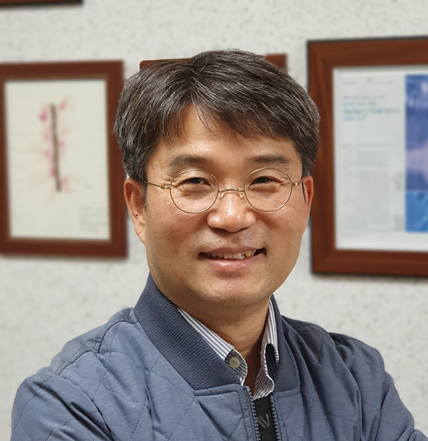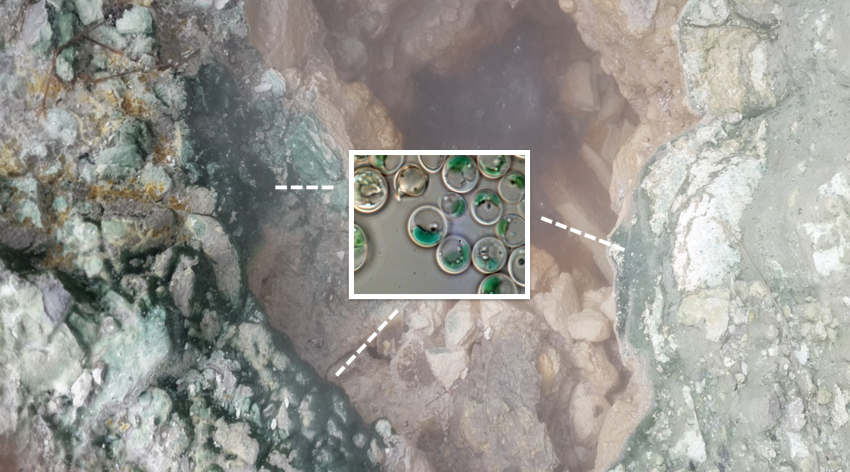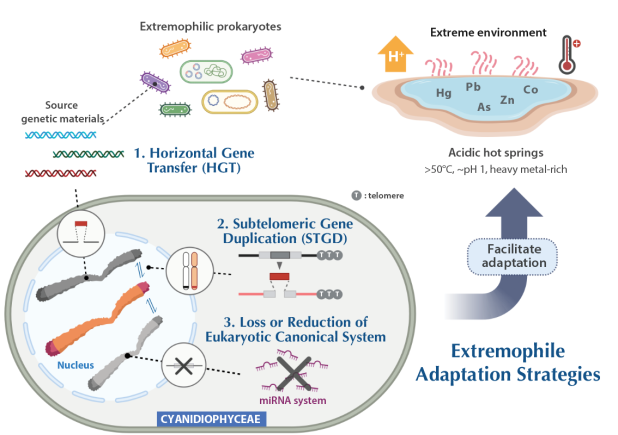Prof. Hwan Su Yoon’s Research Team (Department of Biological Sciences)
Discovers Red Algae Evolution Strategy in Extreme Environment Adaptation
- Confirmed various extreme environment adaptation procedures of Cyanidiophyceae

Prof. Hwan Su Yoon (Department of Biological Sciences, corresponding author) and Dr. Chung Hyun Cho (first author), have announced the discovery of the genome evolution procedure of photosynthesis eukaryotic adaptation to extreme environment.
* Eukaryon: Has a nucleus surrounded by a nuclear membrane and consists of other various cell organelles inside the cell membrane. Undergoes mitosis. All the other microorganisms other than germs and viruses belong to this group.
** Genome: The complete set of genes or genetic material information required for biological phenomena in a cell or organism.
Cyanidiophyceae is the first classification to split from red algae species, ramifying from their common ancestor to adapt to extreme environments such as volcano or thermal spring. Volcano or thermal spring has high temperatures (45~60 ℃), acid concentrations (pH 0~4), and rich heavy metals, forming a harsh environment for organisms to develop in general. However, Cyanidiophyceae is the only eukaryotic organism found in this extreme environment and is the key to the evolution process of organisms that develop in harsh conditions.
Living things in extreme environments are constantly exposed to various external physical and chemical stresses, which interfere with biomaterial metabolism. The research team newly decoded the genome of three kinds of Cyanidiophyceae at the chromosome level to find out how Cyanidiophyceae adapted to this environment. Genetic evolution and adaptability in heavy metal environments were analyzed through genetic comparative analysis which yielded an interesting fact that bacteria and archaea genes of various origins were found in the genome of Cyanidiophyceae.
Cyanidiophyceae externally obtained a gene that neutralizes heavy metals such as arsenic and mercury from bacteria through horizontal gene transfer and later confirmed that they adapted to extreme environments by increasing the number of genes internally through subtelomeric gene duplication.
* Subtelomeric Gene Duplication: Concept of genetics that refers to the transfer of genotypes from individual to individual without reproduction. Can transfer beyond the species.
All key genes related to microRNA, one of the representative gene expression control mechanisms of eukaryotes in Cyanidiophyceae, have disappeared, and in addition, some of the mechanisms unnecessary for extreme environmental survival have been lost in the classification. Moreover, through the evolution process, it was confirmed that the proteins of Cyanidiophyceae were modified and adapted suitably for a high-temperature acidic environment.
The genetic evolution strategy employed to adapt to the polar environment is used in all Cyanidiophyceae species, but the detailed gene and genome composition also differed among Cyanidiophyceae species. Through this study, the team suggested that the differences in genes and genomes that occurred during the speciation process affected the differences in the habitat environment of each species within their current extreme environment.
Prof. Yoon said, “Cyanidiophyceae have strong vitality to adapt to extreme environments and can be used in various applications such as biological heavy metal decontamination, system/synthesis biology, genetic engineering, etc.”
This research was supported by Korea Research Foundation's Mid-size Research Support and Plant Biological Rhythm Leading Research Center. The research results were published in the global academic journal Nature Communications (IF=17.694) on January 4th (Wed).

▲ Cyanidiophyceae-living Sulfur Thermal Spring water of high temperature (45~60 ℃), acidity (pH 0~4), and heavy metal content
 ▲ Extreme Environment Adaptation System of Cyanidiophyceae
▲ Extreme Environment Adaptation System of Cyanidiophyceae
